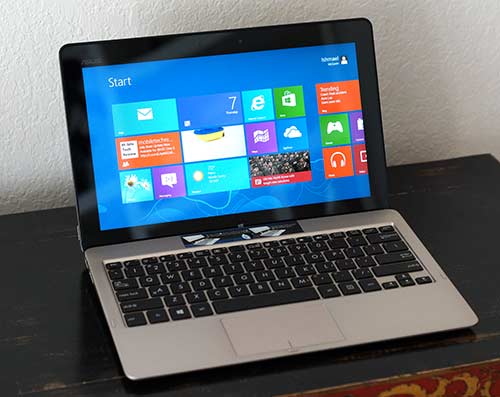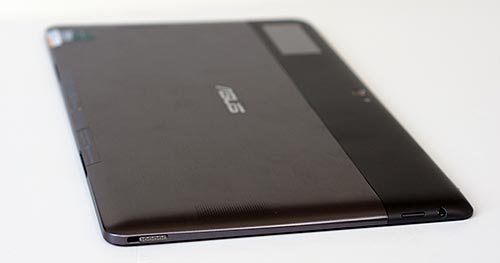Design and Optional Keyboard Dock
The VivoTab is a pleasant looking machine, and not in the least bit flashy. It's finished in subdued silvers and warm tones. The back is mostly metal and there's a broad strip along the top back area because plastic interferes with wireless radios much less than metal. When combined with the optional keyboard dock, the look is less holistic and pleasing, though both the dock and the tablet look good by themselves.
The tablet weighs 1.49 lbs. and the optional dock is 1.5 lbs., making them relatively well balanced. When docked in laptop mode, the display doesn't tilt very far back, but the bright IPS+ display with 178 degree viewing angles doesn't require a wide berth. Balance is reasonably good for a transformer model, and we greatly appreciate the additional 25WHr battery in the keyboard dock that nearly doubles runtimes. The dock has two USB 2.0 ports and a small but usable island style keyboard and passable Synaptics trackpad. Unlike the HP Envy x2, there's no full size SD card slot or other ports on the dock. The latching mechanism is much better than on the Samsung ATIV tablets (it stays connected!) but the side release switch is fiddly and more awkward than the very solid HP Envy x2's docking mechanism. The tablet also wobbles back and forth a bit in the dock, which is disconcerting.
Asus includes a small adapter that connects to the dock port on the bottom to provide a single USB 2.0 port, so you don't have to buy the $199 keyboard dock just to get a USB port for peripherals. The tablet has a micro HDMI port under a very stubborn plastic door and a 3.5mm combo audio jack.
The tablet has rounded sides that are comfortable to hold, and weight is very manageable though it's not as light as the smaller Lenovo ThinkPad Tablet 2 or the Asus MeMO Pad 10 Android tablet. Intel Atom tablets have a silent fanless design and get warm but never hot to the touch.
Display
Yes, everyone wants a super-duper high res display on their tablet thanks to the iPad with Retina Display and upstart Android tablets like the Nexus 10. And yes, the Core i5 Windows 8 tablets have full HD 1080p displays more often than not. That said, Windows 8 Intel Atom tablets have 1366 x 768 displays, and we're not complaining too much since Windows 8 has very crisp typography and these tablets have high quality IPS or PLS displays with wide viewing angles and high contrast. The Asus VivoTab TF810C is no exception, and the IPS+ display has excellent contrast, good colors, very wide viewing angles and better than 350 nits of brightness that put average laptop displays running at the same resolution to shame. It's a very nice display. And the resolution makes for readable text and normal size icons in Windows 8's desktop mode with no scaling required. Still, if super-sharp text and magazine reading with Zinio are your thing, you might wish for that full HD resolution. Zinio's small type in magazine layout mode is hard to read on a 1366 x 768 tablet but readably sharp on a full HD tablet. And yes, if you look close, you can see some staircasing and jaggy text, but you do have to look close.
Wacom Inside
The Asus VivoTAB TF810C, like Samsung ATIV tablets and the ThinkPad Tablet 2, have Wacom digitizers that work with a digital pen for precise input. Writing notes is easy and natural (other than the slippery feel of glass vs. paper) and you can do sophisticated artwork. This is much, much better than a capacitive stylus that feels little better than writing with a finger! You'll get pressure sensitivity in programs that use the newer Windows Ink APIs (ArtRage, Fresh Paint, Autodesk Sketchbook and OneNote 2013) but not older apps that require WinTab drivers like Adobe Photoshop, Corel Painter and PaintTool SAI. So far, Windows 8 Atom tablets all lack WinTab drivers, but we've heard that Adobe is working on creating them. Still, I wouldn't spend $1,000 hoping that the drivers I need will someday appear. If you're a digital artist who needs WinTab now, look elsewhere (the Samsung ATIV Smart PC Pro 700T and the last gen Samsung Series 7 Slate both have Wacom with WinTab drivers).
On another note, we love the included pen. It's a full size pen with a rounded eraser on the end and a button for commands. Folks complain when there's no silo to hold the pen, but if you want a full size pen that's comfortable for extended use, you won't find one that fits in today's super-thin tablets.
Driver Torture
Asus actually released this tablet in early January 2013 in a limited fashion through mostly online retailers with a few bricks and mortar stores like Microcenter thrown in. While even quiet releases from Asus see great driver support via their website and their Live Update app on the device, driver updates were MIA until just a few weeks ago. Given that the Intel Clovertrail Windows 8 tablets had significant early driver issues largely relating to the new Intel chipset and thus plaguing all brands and models, that's a horrid problem. Manufacturers who released models in late fall 2012 pushed out driver updates fairly quickly, while models that came out more recently had newer drives pre-loaded plus downloadable driver updates. These drivers addressed problematic issues like the device not waking from sleep (requiring a forced shutdown and reboot) and sporadic WiFi. Ouch.
Now Asus has drivers available, but only via their Live Update program on the tablet. That might not be so bad were it not for a Live Update app that frequently fails updating itself, let alone other drivers on the device. We had to try several times over the course of two days to get Live Update working. Unfortunately, Asus hasn't published the drivers on their support website to offer an alternative download method as they do for their other tablets and notebooks. This isn't the Asus driver support we know and love, and we do wonder why the VivoTab seems to be the read-headed stepchild.
The Competition and Battery Life
Why choose an Intel Atom Windows 8 tablet when the price verges on Core i5 prices? Battery life, plain and simple. Bonus: a silent and cool running machine. The Asus VivoTab TF810C can run 8 hours on a charge alone and 14 to 15 hours when mated to the optional keyboard dock. In comparison, Microsoft Surface Pro runs 4-5 hours on a charge. Even the Asus Zenbook UX31A Touch Ultrabook, the current Energizer bunny of touchscreen Windows 8 Ultrabooks, only runs 6 hours on a charge.
The VivoTab ships with a small black wall wart charger. The charger output is just 2 amps (same as the iPad and some other tablets). That's not very high output compared to notebook style chargers, so the tablet and dock take up to 6 hours to charge.
Conclusion
The Asus VivoTab TF810C is a lovely Atom Windows 8 transformer whose launch has been hampered by spotty retail presence, a lack of drivers for the first two months and an enormous price tag in the US. Now that Asus has the drivers mostly sorted out, we're more bullish on the tablet, but given its small retail distribution and absent review program, we're not sure how strongly Asus is behind this product. Throw in the high price tag that makes this by far the most expensive Windows 8 Atom tablet, and it's hard to look past these issues and fall in love with the tablet. And that's a shame because the hardware is lovely, the keyboard dock offers a solid typing experience while greatly extending battery life, and it's one of the few with a Wacom digitizer and pen. Top that off with a few less common features like GPS, NFC and a truly decent 8MP rear camera and the VivoTab TF810C has what it takes to stand out.
Price: $799 for the 64 gig tablet, $199 for the keyboard dock
| 


No comments:
Post a Comment